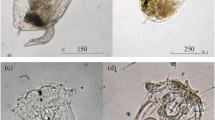Abstract
Although closely resembling Anuraeopsis fissa, Anuraeopsis miracleae constitutes a well defined species, being more highly adapted to microaerobic, cold environments. Our observations on the Austrian population are compared with information available on specimens from the type locality in Spain. Morphological discrepancies, especially concerning characteristics of Weber's organ and shape of the eggs are described and discussed. General ecological features indicate that the species is not restricted to meromictic or stratified lakes.
To agree with the provisions of the International Code of Zoological Nomenclature the original spelling of A. miraclei Koste, 1991 is emended to A. miracleae Koste, 1991.
Similar content being viewed by others
References
Bērziņš, B. & B. Pejler, 1989a. Rotifer occurrence in relation to temperature. Hydrobiologia 175: 223–231.
Bērziņš, B. & B. Pejler, 1989b. Rotifer occurrence in relation to oxygen content. Hydrobiologia 183: 165–172.
Bogaert, G. & H. J. Dumont, 1989. Community structure and coexistence of the rotifers of an artificial crater lake. In C. Ricci, T. W. Snell & C. E. King (eds), Rotifer Symposium V. Developments in Hydrobiology 52. Kluwer Academic Publishers, Dordrecht: 167–179. Reprinted from Hydrobiologia 186/187.
De Beauchamp, P. M., 1909. Recherches sur les rotifères:: les formations tégumentaires et l'appareil digestif. Arch. Zool. exp. gén. 10: 1–410.
Donner, J., 1943. Zur Rotatorienfauna Südmährens. Zool. Anz. 143: 21–33.
Esparcia, A., J. Armengol, E. Vicente & M. R. Miracle, 1991. Vertical distribution of Anuraeopsis species related to oxygen depletion in two stratified lakes. Verh. int. Ver. Limnol. 24: 2745–2749.
Gannon, J. E. & R. S. Stemberger, 1978. Zooplankton (especially crustaceans and rotifers) as indicators of water quality. Trans. am. Microsc. Soc. 97: 16–35.
Hakkari, L., 1972. Zooplankton species as indicators of environment. Aqua fern. 1972: 46–54.
Hofmann, W., 1987. Population dynamics of hypolimnetic rotifers in the Pluss-see (North Germany). In L. May, R. Wallace & A. Herzig (eds), Rotifer Symposium IV. Developments in Hydrobiology 42. Dr W. Junk Publishers, Dordrecht: 197–201. Reprinted from Hydrobiologia 147.
Hudson, C. T. & P. H. Gosse, 1886. The rotifera or wheelanimalcules, both British and foreign. London, I: 1–128; II: 1–144.
Koste, W., 1978. Rotatoria. Die Rädertiere Mitteleuropas. Überordnung Monogononta. Begründet von M. Voigt Gebrüder Borntraeger, Berlin, Stuttgart. I. Textbd. VIII + 1–673, II. Tafelbd. III + 1–476.
Koste, W., 1991. Anuraeopsis miraclei, a new planktonic rotifer species in karstic lakes of Spain. Hydrobiologia 209: 169–173.
Miracle, M. R. & E. Vicente, 1983. Vertical distribution and rotifer concentrations in the chemocline of meromictic lakes. In B. Pejler, R. Starkweather & T. Nogrady (eds), Biology of Rotifers. Developments in Hydrobiology 14. Dr W. Junk Publishers, The Hague: 259–267. Reprinted from Hydrobiologia 104.
Pejler, B., 1957. Taxonomical and ecological studies on planktonic rotatoria from northern Swedish Lapland. K. V. A. Handl. 6/5: 1–68.
Pejler, B., 1983. Zooplanktic indicators of trophy and their food. In C. Forsberg & J.-A. Johansson (eds), Forest Water Ecosystems. Developments in Hydrobiology 13. Dr W. Junk Publishers, The Hague: 111–114. Reprinted from Hydrobiologia 101.
Pejler, B. & B. Bērzinņš, 1989. On choice of substrate and habitat in brachionid rotifers. In C. Ricci, T. W. Snell & C. E. King (eds), Rotifer Symposium V. Developments in Hydrobiology 52. Kluwer Academic Publishers, Dordrecht: 137–144. Reprinted from Hydrobiologia 186/187.
Schaber, P. & A. Schrimpf, 1984. On morphology and ecology of the Filinia-terminalis-longiseta-group (Rotatoria) in Bavarian and Tyrolean lakes. Arch. Hydrobiol. 101: 247–257.
Sudzuki, M., 1957. Studies on the egg-carrying types in rotifera III. Genus Anuraeopsis (Japan., engl. summ.). Zool. Mag. (TOKYO) 66: 407–415.
Weber, F., 1898. Faune rotatorienne du bassin de Léman. Rev. Suisse Zool. 5: 263–785.
Author information
Authors and Affiliations
Rights and permissions
About this article
Cite this article
Jersabek, C.D., Koste, W. Additional notes on taxonomy and ecology of Anuraeopsis miracleae Koste, 1991 (Rotatoria:Monogononta) from an Austrian alpine lake. Hydrobiologia 264, 55–60 (1993). https://doi.org/10.1007/BF00014664
Received:
Revised:
Accepted:
Issue Date:
DOI: https://doi.org/10.1007/BF00014664




